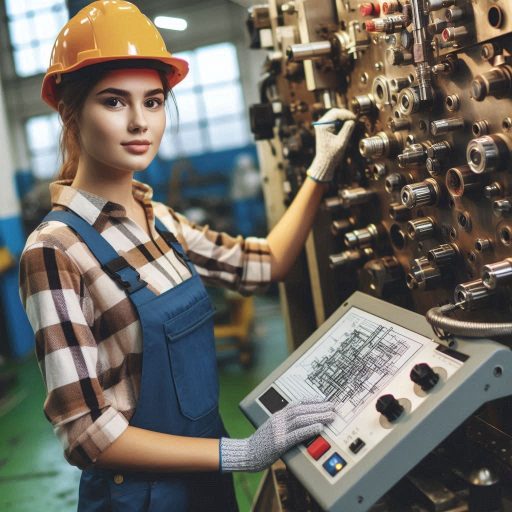Introduction
Importance of Tools and Equipment for Industrial Mechanics
Tools and equipment are essential for industrial mechanics, enabling them to perform tasks efficiently and accurately.
They are fundamental in maintaining and repairing complex machinery, ensuring that operations run smoothly.
Proper tools enhance productivity, allowing mechanics to complete tasks quickly and effectively, reducing downtime.
Using the right equipment also improves the quality of work, leading to better outcomes and fewer errors.
The correct tools contribute significantly to workplace safety, minimizing the risk of injury and ensuring that mechanics handle tasks safely.
For instance, precision tools allow for accurate measurements and adjustments, crucial for reliable machinery operation.
Setting the Stage for the Different Types of Tools and Equipment
This will delve into the various types of tools and equipment that are crucial for industrial mechanics.
We will explore power tools such as drills, grinders, and saws, which are essential for heavy-duty tasks.
Additionally, we will discuss hand tools, measuring instruments, and safety equipment.
Each type of tool plays a specific role in daily operations, contributing to the efficiency, precision, and safety of mechanical work.
Understanding these tools’ functions and benefits will highlight their importance in the industry.
Hand Tools
Essential Hand Tools for Industrial Mechanics
Industrial mechanics rely on a range of essential hand tools to perform their tasks efficiently.
These tools include wrenches, screwdrivers, pliers, and hammers.
Wrenches come in various types, such as adjustable, combination, and socket wrenches, and are crucial for loosening and tightening bolts.
Screwdrivers, including flathead and Phillips, are used for driving screws into place.
Pliers, including needle-nose and slip-joint, are necessary for gripping, bending, and cutting wire.
Hammers, such as claw and ball-peen, are used for striking and shaping materials.
Other important tools include utility knives, tape measures, and levels.
Each of these tools plays a specific role in the maintenance and repair of machinery.
Importance of Having Quality Hand Tools for Efficient Work
Having quality hand tools is vital for efficient work in industrial settings.
High-quality tools ensure better performance, durability, and reliability.
They can withstand the rigors of daily use, reducing the risk of breakage.
Quality tools also provide better precision and control, leading to more accurate work.
Using subpar tools can lead to inefficient work, increased downtime, and potential damage to machinery.
Investing in high-quality hand tools enhances overall productivity and reduces maintenance costs.
It ensures that tasks are completed effectively and safely, minimizing the risk of accidents or injuries.
Tips for Maintaining and Organizing Hand Tools in the Workshop
Proper maintenance and organization of hand tools are crucial for optimal performance and longevity.
Regularly clean tools to remove dirt, rust, and debris.
Store tools in a designated area to prevent loss and damage.
Use toolboxes or tool chests to keep tools organized and easily accessible.
Label drawers and compartments to quickly find the right tool.
Inspect tools regularly for signs of wear and tear, and replace damaged or worn tools promptly.
Ensure that tools are kept in good working condition to avoid compromising safety and efficiency.
Implementing a maintenance schedule helps in prolonging the life of tools and ensures they are always ready for use.
Additionally, keep a checklist of tools to monitor their condition and availability.
On a final note, industrial mechanics depend on a variety of essential hand tools to perform their duties efficiently.
Quality tools are crucial for effective work, offering durability and precision.
Regular maintenance and proper organization of tools are necessary for maintaining their performance and longevity.
By investing in high-quality tools and following best practices for maintenance and organization, industrial mechanics can enhance their productivity and ensure a safe and efficient working environment.
Power Tools
Overview of the Different Types of Power Tools Used by Industrial Mechanics
Industrial mechanics rely on various power tools to handle heavy-duty tasks efficiently.
Drills are essential for creating holes in different materials, including metal and wood.
They come in various types, including corded and cordless, to suit different applications.
Grinders are crucial for cutting, grinding, and polishing metal surfaces.
They can be used to remove rust or smooth rough edges.
Saws, such as circular saws and reciprocating saws, are used for cutting through materials like metal and wood.
Each type of saw serves a specific purpose, with variations designed for precision or heavy-duty cuts.
Impact wrenches are invaluable for loosening or tightening bolts and nuts quickly.
They save time and effort compared to manual wrenches.
Sander tools help in smoothing surfaces and preparing them for finishing.
These tools, combined, help industrial mechanics work more efficiently and accurately.
Benefits of Using Power Tools for Heavy-Duty Tasks
Power tools offer significant advantages for heavy-duty tasks in industrial settings.
They provide increased efficiency, allowing mechanics to complete tasks faster.
Using power tools reduces physical strain, minimizing fatigue and the risk of injury.
For example, impact wrenches significantly speed up the process of tightening bolts, which can be time-consuming with manual tools.
Power tools enhance precision and consistency, leading to higher quality results.
They can handle tougher materials and larger volumes of work than manual tools.
Additionally, power tools often come with adjustable settings, enabling mechanics to tailor their usage to specific tasks.
This versatility makes them indispensable for a wide range of applications.
Overall, power tools improve productivity and precision in industrial mechanics’ work.
Safety Precautions When Using Power Tools in the Workshop
Safety is paramount when using power tools in the workshop.
Always wear appropriate personal protective equipment (PPE), including safety glasses, gloves, and ear protection.
Ensure that power tools are properly maintained and regularly inspected for wear and tear.
Before using a tool, read the manufacturer‘s instructions and understand its operation.
Keep work areas clean and free of obstructions to avoid accidents.
Use tools according to their intended purpose and avoid making modifications that could compromise safety.
Ensure that all safety guards are in place and functional.
Always disconnect power sources when changing accessories or performing maintenance.
Train all personnel in the proper use of power tools and the importance of safety procedures.
By following these precautions, mechanics can reduce the risk of accidents and injuries, ensuring a safer work environment.
Power tools, including drills, grinders, saws, and impact wrenches, are essential for industrial mechanics.
They enhance efficiency, precision, and ease of use for heavy-duty tasks.
The benefits of using power tools include increased speed, reduced physical strain, and improved accuracy.
However, safety precautions are critical when using these tools.
Proper use, regular maintenance, and adherence to safety guidelines help prevent accidents and ensure a safe working environment.
By integrating these practices, industrial mechanics can work more effectively while maintaining high safety standards.
Diagnostic Equipment
Diagnostic Equipment Used to Troubleshoot Machinery Issues
There is essential for identifying and resolving machinery issues.
These tools help mechanics pinpoint problems accurately, reducing downtime and improving productivity.
By using diagnostic equipment, mechanics can assess the condition of machinery components and detect malfunctions before they escalate.
Diagnostic tools measure various parameters, including electrical signals, pressure, and temperature.
These measurements provide valuable insights into the machinery‘s performance and help identify issues such as wear and tear or system malfunctions.
Accurate diagnostics lead to precise repairs, which enhance the machinery’s reliability and efficiency.
Importance of Accurate Diagnostics for Efficient Repairs
Accurate diagnostics are crucial for efficient repairs.
They allow mechanics to identify the root cause of problems rather than just addressing symptoms.
This approach prevents recurring issues and minimizes the risk of future breakdowns.
Proper diagnostics also ensure that repairs are targeted and effective, which saves time and reduces repair costs.
Efficient repairs rely on understanding the underlying issues.
Diagnosing problems accurately helps in selecting the correct repair methods and replacement parts.
This accuracy is essential for maintaining machinery performance and extending its operational lifespan.
Examples of Common Diagnostic Equipment Used in Industrial Settings
Several types of diagnostic equipment are commonly used in industrial settings:
- Multimeters: These devices measure electrical properties such as voltage, current, and resistance. Mechanics use multimeters to check electrical circuits and identify faults.
- Oscilloscopes: Oscilloscopes capture and display electrical waveforms. They help diagnose issues with electronic components by analyzing signal patterns.
- Pressure Gauges: Pressure gauges measure the pressure of fluids within machinery systems. They are crucial for identifying issues in hydraulic and pneumatic systems.
- Thermal Cameras: These cameras detect heat patterns and identify overheating components. They are useful for spotting electrical faults and mechanical wear.
- Vibration Analyzers: Vibration analyzers measure machine vibrations and detect imbalances or misalignments. They help prevent equipment failures by identifying issues early.
- Borescopes: Borescopes provide visual inspections inside machinery components. They allow mechanics to view internal conditions without disassembling equipment.
Overall, Diagnostic equipment is vital for industrial mechanics to troubleshoot and repair machinery effectively.
Accurate diagnostics enable targeted repairs and improve machinery performance.
Common tools like multimeters, oscilloscopes, and thermal cameras are essential for detecting and resolving issues.
Using these tools ensures efficient maintenance and enhances the reliability of industrial machinery.
By understanding and utilizing diagnostic equipment, mechanics can perform precise repairs and extend the lifespan of machinery.
Read: Best Online Courses for CAD Technician Training
Lifting Equipment
Description of Different Types of Lifting Equipment
Industrial mechanics use various types of lifting equipment to handle heavy machinery and components.
Cranes are versatile tools that can lift and move large items in different directions.
They come in various types, including overhead, tower, and mobile cranes.
Hoists are another essential lifting tool, used for lifting and lowering loads.
They are often mounted on a fixed location and can be manual or electric.
Forklifts are commonly used to move materials around the workshop.
They have forks that can lift pallets and heavy items.
Jacks are used for smaller lifting tasks and are crucial for changing tires or lifting machinery components.
Lift tables provide adjustable heights for various maintenance tasks, making it easier to work at different levels.
Each type of lifting equipment plays a vital role in the workshop, improving efficiency and safety during heavy lifting tasks.
Safety Guidelines for Using Lifting Equipment in the Workshop
Safety is paramount when using lifting equipment in the workshop.
Always inspect lifting equipment before use to ensure it is in good condition.
Check for any signs of wear or damage, such as frayed cables or bent hooks.
Ensure that the lifting equipment is operated by trained personnel who understand its proper use.
Follow the manufacturer‘s instructions for operating the equipment to avoid accidents.
Never exceed the maximum load capacity specified for the equipment.
Use proper lifting techniques and avoid placing yourself or others under the load being lifted.
Ensure that the area around the lifting equipment is clear of obstructions and bystanders.
Use safety barriers if necessary to keep unauthorized personnel away from the lifting zone.
Regularly review and update safety protocols to adapt to new risks or equipment changes.
Properly secure loads before lifting to prevent shifting or dropping during the process.
Maintaining awareness of these safety guidelines helps prevent accidents and ensures a safe working environment.
Proper Maintenance of Lifting Equipment
Proper maintenance of lifting equipment is essential for safety and longevity.
Perform regular inspections to identify any wear and tear or mechanical issues.
Lubricate moving parts according to the manufacturer’s recommendations to ensure smooth operation.
Replace any worn or damaged components immediately to prevent malfunction.
Keep lifting equipment clean and free from debris that could impair its function.
Follow a scheduled maintenance plan that includes checking hydraulic systems, cables, and controls.
Document all maintenance activities and repairs to track the equipment’s condition over time.
Store lifting equipment in a dry, protected area to prevent rust and corrosion.
Train personnel on proper maintenance procedures to ensure they are aware of potential issues and how to address them.
By adhering to these maintenance practices, you can extend the lifespan of the equipment and maintain a safe, efficient workshop environment.
Lastly, Lifting equipment is crucial in industrial mechanics, enabling the handling of heavy machinery and components.
Cranes, hoists, forklifts, jacks, and lift tables each serve specific functions.
Adhering to safety guidelines and performing regular maintenance ensures the equipment operates safely and efficiently.
Regular inspections, proper usage, and routine upkeep are vital to preventing accidents and prolonging the equipment‘s life.
By following these practices, industrial mechanics can create a safer, more effective workshop environment.
Read: Common Mistakes in Quality Control Inspections

Welding Equipment
Types of Welding Equipment Used in Industrial Settings
Welding is a crucial skill for industrial mechanics, and various tools and equipment are essential for effective welding tasks.
Welding machines, such as MIG (Metal Inert Gas) and TIG (Tungsten Inert Gas) welders, are commonly used.
MIG welders are versatile and ideal for thick materials, while TIG welders offer precision for thin metals.
Plasma cutters are used to cut metals with high accuracy.
Welding helmets protect mechanics from intense light and heat during the welding process.
These helmets often feature auto-darkening filters that adjust to the brightness of the weld.
Welding gloves, typically made of heat-resistant materials, safeguard hands from burns and sparks.
Additionally, protective aprons and jackets help cover other parts of the body from hot metal splashes and UV radiation.
Importance of Proper Training and Certification for Welding Tasks
Proper training and certification are vital for performing welding tasks safely and effectively.
Mechanics must understand various welding techniques and the properties of different metals.
Certification programs ensure that welders are skilled in operating welding equipment and adhering to industry standards.
Training covers essential aspects, such as welding safety, machine operation, and quality control.
Certified welders are recognized for their competence, which enhances job prospects and ensures high-quality work.
Certification programs also offer updated knowledge on new welding technologies and techniques.
This continuous learning helps welders stay current with industry advancements and maintain their proficiency.
Safety Measures to Prevent Accidents While Welding
Safety is paramount in welding to prevent accidents and injuries.
Mechanics should always wear appropriate personal protective equipment (PPE), including helmets, gloves, and protective clothing.
Ensuring proper ventilation is crucial to avoid inhaling harmful fumes generated during welding.
Mechanics should work in well-ventilated areas or use exhaust systems to maintain air quality.
Before starting work, it is essential to inspect welding equipment for defects or malfunctions.
Proper maintenance of equipment reduces the risk of accidents caused by faulty machinery.
Additionally, keeping flammable materials away from the welding area prevents fires and explosions.
Mechanics should also be trained in emergency procedures to handle potential accidents, such as burns or electrical shocks.
Regular safety audits and adherence to safety protocols ensure a safe working environment.
Welders should also stay informed about best practices and industry safety standards.
Following these measures helps prevent accidents and promotes a safe and productive work environment.
Transform Your Career Today
Unlock a personalized career strategy that drives real results. Get tailored advice and a roadmap designed just for you.
Start NowIndustrial mechanics rely on various tools and equipment for welding, including welding machines, helmets, and gloves.
Proper training and certification are crucial for performing welding tasks effectively and safely.
Safety measures, such as using PPE and maintaining equipment, are essential to prevent accidents and ensure a safe work environment.
By understanding and implementing these aspects, industrial mechanics can perform their tasks efficiently while minimizing risks and ensuring high-quality results.
Read: Interview Tips for Aspiring Radiologic Technologists
Measuring Tools
Overview of Essential Measuring Tools
Industrial mechanics rely heavily on accurate measurements to ensure proper equipment function.
Essential measuring tools include calipers, micrometers, and tape measures.
Calipers measure internal and external dimensions with precision.
They come in digital, dial, and vernier types.
Micrometers are used for extremely precise measurements of small dimensions, typically in the range of micrometers.
They are crucial for tasks requiring high accuracy.
Tape measures provide quick measurements of larger dimensions and are essential for layout tasks.
Each tool serves a unique purpose, and using the right one for the job ensures accuracy and efficiency.
These measuring tools are vital for tasks ranging from alignment to installation.
Precision and Accuracy in Measurements
Precision and accuracy in measurements are critical for successful repairs and installations.
Incorrect measurements can lead to equipment malfunctions or failures.
For instance, misaligned parts can cause excessive wear and tear.
Accurate measurements ensure that components fit correctly and function as intended.
Using high-quality tools and following proper measurement techniques are key to achieving accuracy.
Regularly checking and calibrating your measuring instruments also enhances their reliability.
Precision in measurements helps prevent costly mistakes and downtime.
Ensuring all parts meet exact specifications is crucial for maintaining machinery efficiency and longevity.
Properly executed measurements contribute to the overall success of repair and maintenance tasks.
Tips for Calibration and Maintenance of Measuring Tools
Maintaining and calibrating measuring tools is essential for their accurate performance.
Regular calibration ensures that tools remain precise over time.
Follow the manufacturer‘s guidelines for calibration intervals and procedures.
Store measuring tools in a clean, dry place to prevent damage.
Keep them free from dust and debris that can affect accuracy.
Inspect tools for signs of wear or damage before each use.
Replace worn or damaged parts as needed to maintain functionality.
For tools with digital displays, replace batteries as recommended to avoid power issues.
Regular maintenance and proper handling extend the life of measuring tools and ensure their continued accuracy.
By keeping tools in optimal condition, mechanics can perform tasks more effectively and avoid measurement-related errors.
Investing in Quality Measuring Tools
Investing in high-quality measuring tools pays off in accuracy and durability.
Premium tools offer better performance and longer lifespan.
Although they may have a higher initial cost, their reliability and precision make them a worthwhile investment.
High-quality tools reduce the likelihood of measurement errors and enhance overall work quality.
Ensure that tools are sourced from reputable manufacturers known for their precision engineering.
Proper investment in quality tools can significantly impact the success of maintenance and repair tasks.
Quality tools not only improve measurement accuracy but also contribute to smoother and more efficient operations.
In short, understanding and properly using essential measuring tools are crucial for industrial mechanics.
Calipers, micrometers, and tape measures each play a vital role in achieving precise measurements.
Maintaining accuracy and precision in measurements ensures successful repairs and installations.
Regular calibration and proper maintenance of these tools enhance their performance and longevity.
Investing in high-quality tools further supports accurate and efficient work, ultimately benefiting the overall operation and maintenance of industrial machinery.
Read: Continuing Education for Radiologic Technologists
Cleaning Equipment
Cleaning Equipment Used in Industrial Workshops
Industrial workshops rely on various cleaning equipment to maintain machinery and ensure a safe working environment.
Pressure washers are essential for removing dirt, grime, and other contaminants from machinery and surfaces.
They use high-pressure water jets to clean equipment effectively and quickly.
Degreasers are another crucial tool, designed to break down and dissolve grease and oil that accumulate on machinery.
They come in various forms, including sprays, foams, and solvents, tailored for different cleaning tasks.
Industrial vacuum cleaners are also vital in workshops, especially for removing dust and debris from work areas.
These vacuums can handle large volumes of particulate matter, improving air quality and reducing the risk of accidents.
Ultrasonic cleaners use high-frequency sound waves to remove contaminants from delicate components.
They are especially useful for cleaning small parts and intricate machinery.
Importance of Cleanliness for Maintaining Machinery
Maintaining cleanliness in industrial workshops is crucial for the longevity and efficiency of machinery.
Accumulated dirt, grease, and debris can cause wear and tear on equipment, leading to premature failures.
Regular cleaning helps prevent these issues by ensuring that machinery operates smoothly and efficiently.
Clean equipment is less likely to overheat or malfunction, which can reduce downtime and maintenance costs.
Cleanliness also contributes to a safer work environment.
Removing contaminants reduces the risk of slips, falls, and other accidents.
It also helps prevent the spread of hazardous substances, which can pose health risks to workers.
By keeping the workshop clean, you ensure that equipment remains in good condition and that workers operate in a safe and hygienic environment.
Proper Disposal of Waste Materials and Hazardous Substances
Proper disposal of waste materials and hazardous substances is a critical aspect of maintaining an industrial workshop.
Waste materials, such as used rags, broken parts, and cleaning residues, must be disposed of according to local regulations.
Many industrial facilities have designated bins and procedures for disposing of these materials safely.
Hazardous substances, such as used degreasers and chemical cleaners, require special handling and disposal.
They should never be poured down drains or mixed with regular waste.
Instead, follow proper disposal protocols, which may include using designated disposal services or recycling programs.
Many regions have specific guidelines for handling and disposing of hazardous materials, so be sure to familiarize yourself with these regulations.
Implementing waste management practices helps minimize environmental impact and ensures compliance with safety regulations.
It also promotes a cleaner and more organized workshop environment.
Providing training for employees on proper disposal methods and maintaining up-to-date disposal procedures are essential for effective waste management.
In summary, using appropriate cleaning equipment, maintaining cleanliness, and properly disposing of waste and hazardous substances are key to effective industrial workshop management.
These practices ensure machinery remains in optimal condition, create a safer work environment, and help comply with environmental regulations.
See Related Content: Latest Trends in Cybersecurity Analyst Technologies
Conclusion
Different Types of Tools and Equipment
In industrial mechanics, having the right tools and equipment is crucial.
Essential tools include wrenches, screwdrivers, pliers, and hammers.
Wrenches are vital for loosening and tightening bolts.
Screwdrivers handle various types of screws, while pliers are used for gripping, bending, and cutting.
Hammers are necessary for striking and shaping materials.
Each tool plays a specific role in maintaining and repairing machinery.
Importance of Having the Right Tools
The importance of having quality tools cannot be overstated.
High-quality tools offer better performance, durability, and precision.
They reduce the risk of equipment failure and ensure accurate work.
Subpar tools can lead to inefficiencies, increased downtime, and potential safety hazards.
Encouragement to Invest in Quality Tools
Investing in quality tools is crucial for enhancing productivity and ensuring a safer working environment.
Regularly clean and organize your tools to keep them in optimal condition.
A well-maintained toolset supports effective task completion and prevents unnecessary delays.
By prioritizing high-quality tools and proper care, you achieve better results and maintain efficiency in industrial settings.
[E-Books for Sale]
The Big Book of 500 High-Paying Jobs in America: Unlock Your Earning Potential
$19.99 • 500 High-Paying Jobs • 330 pages
Explore 500 high-paying jobs in America and learn how to boost your career, earn more, and achieve success!
See All 500 High-Paying Jobs of this E-Book
1001 Professions Without a Degree: High-Paying American Jobs You Can Start Now
$19.99 • 1001 Professions Without a Degree • 174 pages
Discover 1001 high-paying jobs without a degree! Unlock career tips, skills, and success strategies for just $19.99!




